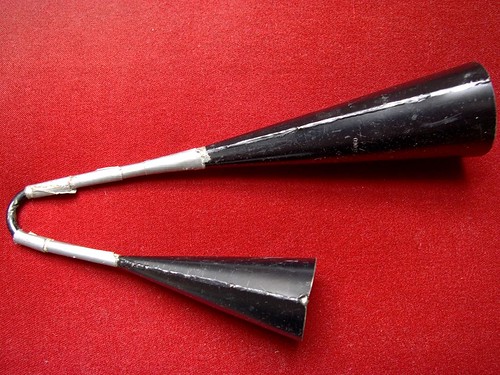by Bill Benzon
Call it “animism” if you wish, but it will no longer be enough to brand it with the mark of infamy. This is indeed why we feel so close to the sixteenth century, as if we were back before the “epistemological break,” before the odd invention of matter.
—Bruno Latour, An Attempt at a “Compositionist Manifesto”
This essay starts with an experience I had some years ago in a basement in Troy, New York, while rehearsing with three colleagues: Ade (who had toured with Gil Scott-Heron in his youth), Druis, and Fonda. We were each of us playing bells when at some point we heard high-pitched twittering sounds that none of us were playing. Where did they come from? What were they?
I can easily imagine how someone might think they were hearing a spirit or spirits. The Western scientific impulse is quite different. We know that spirits do not exist and therefore there must be some other, some physically plausible, account of those twittering sounds. My purpose here is not to reject the physical account. On the contrary, I believe it to be foundational. But I also believe that, carefully considered, it points to a way of making sense of the idea of spirit.
Instrument and Player
It is well known that B.B. King’s guitar is named Lucille. Why is it named at all? Perhaps it’s a gesture of affection. The guitar, after all, is very close to him. It is one of his voices; it is, in some sense, part of him.
It may be more than that. The name may well reflect the subtle intricacy of King’s relationship to his guitar, his instrument. To play an instrument well, one must learn to yield to its physicality, to blend with it. You cannot dominate it. Well, you can try, and you CAN succeed. But you pay a cost. Your musicianship suffers.
As I’m not a guitar player, however, I can’t tell you what it means to yield to a guitar. I suppose I could talk about the trumpet—I’ve been playing one for half a century—but that’s just a little complex. And my point really isn’t about complexity. It’s about subtlety.
Let us begin by talking about playing a very simple instrument, the claves.
The claves are a pair of short sticks that tend to be roughly eight inches long and an inch in diameter. They’re used in many genres of Latin music to produce a sharp penetrating percussive sound. They’re usually made of hard dense wood. Mine are made of fiberglass (see below). You hold one clave in your left hand and then strike it with the other one, held in your right hand (if you’re right handed).
It’s more like you cradle one clave (it doesn’t matter which one) in your left hand. You hold your hand palm-up, lay the clave across it, and grip it only so much as needed to keep it in place. You do not need to grip it tightly, nor do you even WANT to grip it tightly. If you do that, then your hand will dampen the vibrations and dull the sound. The ‘crack!’ will no longer be sharp and crisp.
You must of course grip the other clave to keep it from falling to the ground. But, and here is the subtlety, you do WANT it to fall, which is its natural behavior under gravity. It should fall toward the stationary clave and rebound from it. The quicker the two sticks separate after impact, the sharper and louder the sound. There’s nothing you can do with your will and muscle that is more effective than simply getting out of the way. Let natural elasticity do its work.
Use your right hand to regulate how the clave falls. In effect, you’re dropping the clave and using your right hand to follow the fall. For a soft sound, start the fall close to the target clave. If you start the fall further away, you’ll get a louder sound. For a still louder sound, you can impart energy to the clave with your hand. Now you ARE gripping it and dominating it, but just a bit.
Played in this way it is easy to get a loud satisfying crack from the claves with little effort, an important consideration if you’re playing a four or five hour gig. But, if you don’t know this, if you have never been shown or never figured it out, you can exert considerably more effort playing the claves, and get much less sound from that effort.
I witnessed that several years ago when I was working with a street band in New York City. I played trumpet most of the time, but had some bells and the claves for people to pick up and join the band. One young man who said he was a drummer wanted to play the claves. I gave them to him and away he went.
He gripped each clave hammer-style, and then banged the free ends together with fairly considerable force. He hit them so hard that he managed to knock small chips out of them. These claves were made of fiberglass specifically so they could withstand hard use; that’s why I bought them. And yet the man managed to knock chips out of them while not getting much sound out of them at all. As I recall, he noticed that himself and was frustrated, but the situation wasn’t one where I could stop what I was doing and give him a clave lesson in mid-performance. Nor was it obvious to me that he would have gotten the lesson quickly. He seemed determined to demonstrate his will and enthusiasm by expending maximum effort.
The point, then, is that technique matters, and that just what and how it matters is not immediately obvious. The musician must assimilate the instrument to their body schema and play it as though it were their own body. Just what that entails will vary from one instrument to another. For example, the physical aspects of playing the trumpet (my main instrument) are quite different from playing the claves; they are more difficult to conceptualize as they involve the mouth (lips, teeth and tongue); the arms, hands, and fingers; and the trunk and breathing apparatus. But we don’t need to deal with all that, as my primary example is very much like the claves.
The Magic of the Bell
It involves playing bells, such as those following this paragraph. You hold the bell or bells in one hand and a beater, often an ordinary drum stick, in the other. But the bells give you more options than the clave; they have more affordances, to use a term from the ecological psychology of J. J. Gibson. Exactly where and how hard you hit matters, as does just how you grip the bell. You can also damp the sound with your fingers or by lowering the bell to your thigh (when playing while seated).
The bells really get interesting when played in a group, for now you have multiple bell sounds interacting with one another. I’ve described how this works in Beethoven’s Anvil (pp. 23-24). This paragraph describes the basic phenomenon:
This is a story about me and three other musicians. Led by Ade Knowles, we were rehearsing a piece based on Ghanaian musical principles. Each of us had a bell with two or three heads on it—the bells were of Ghanaian manufacture. Ade assigned three of us simple interlocking rhythms to play and then improvised over the interlocking parts. Once the music got going, melodies would emerge which no one was playing. The successive tones one heard as a melody came first from one bell then another and another. No person was playing that melody; it arose from cohesions in the shifting pattern of tones played by the ensemble. Depending on the patterns he played, Ade could direct the tonal stream perceived as the melody, but the tones he played weren't necessarily the melody tones. Rather, they served to direct the melodic cohesions from place to place.
Those emergent melodies are important. They were and are clear and obvious, a single discrete stream of tones where the individual tones were played by different individuals rather than all of them being played by a single individual. Because no one person was playing every note in these emergent melody lines, we can take these lines as a phenomenon and expression of group unity. In fact, those interlocking and emergent lines in African bell choirs and drum choirs have posed considerable problems for ethnomusicologists. It is all but impossible to figure out what the individual lines are simply by listening to the whole. At the same time, it is difficult for individual musicians to play a single line without the support of the whole group.
Think about those two related phenomena for a moment. The auditory array has a segmentation that is natural to the human ear, but that segmentation doesn’t divide the array into streams each of which is executed by a single individual. At the same time individuals cannot properly execute his or her own component without hearing the others with which it is interlinked. It is not merely that the sonic array is being created by a group, but that the group seems to have entered the mind of each individual so that individual actions require group support and the “virtual” actors one hears, the auditory streams, are each of them products of group action.
Let’s get back to those bells. Now the event gets even more subtle and interesting (Beethoven's Anvil, p. 24):
Occasionally, something quite remarkable would happen. When we were really locked together in animated playing we could hear relatively high-pitched tones that no one was playing. That is, while each bell had a pitch tendency (these bells were not precisely tuned), these particular high tones did not match the pitch tendency of any bell. The tones were distinct, but not ones that any of us appeared to be playing.
These tones only appeared when we were in the state of relaxation conducive to intense playing, a groove, if you will—a groove I could certainly feel as a “buzz” in my body. Without the relaxation, no emergent tones and melodies. According to Ade, that's how it always is. The “magic” of the bell happens only when the musicians are in a groove. My friend Jon Barlow tells me that a similar phenomenon is familiar to people who gather together and chant long tones in unison. When the chanting is going well, and only then, the chanters hear distinct and relatively high-pitched tones that seem to be located near the room’s ceiling. It is those magic tones (for what it is worth, about 2000 Herz and above), tones played by no one at all, but emerging through the group to form their own auditory stream, that is what I want you to think about—I certainly did, for years, and I am still thinking about them. If I hadn’t ‘known better’ I would have said, straight up, that they were spirit voices, or some such thing. But I believed then, and now, that such spirits do not and cannot exist.
If I couldn’t call them spirit voices then what could I call them?
I searched for written accounts of the phenomenon, but could find none, though I found accounts of similar phenomenon. I made inquiries of other musicians, ethnomusicologists, and experts in psychoacoustics. No one was familiar with the phenomenon; though some offered an opinion that the sounds may well have been real sounds that one could pick up with microphones and record on tape. That’s what I think, too. But none of us really knows.
The phenomenon remains something a puzzle.
Spirits, Why Not?
Why not think of this twittering bell tones as manifestation of spirits? But not spirits conceived as incorporeal sprites littering hither and yon in the material universe in mysterious ways. Rather, they are concrete and indivisible manifestations of group activities. They express and are deeply grounded in collectivity.
To that end I insist on treating the sounds and their performance context as a single unified entity. Without that context, which of course includes the performers, then, yes, those sounds are just sounds. If we had recorded that rehearsal, only the sounds would be in the recording, but not the spirits of which they are manifestations. For those things I am calling spirits are intermingled with the performers and are not physically separable from them.
It is important to emphasize that those sounds happened only when we were in a focused state of mind. The sounds existed only through our collective interaction. It is that collectivity as it “attaches” itself to the sounds that I am calling a spirit. The sounds are an audible manifestation of a special and temporary relationship among the four of us. To say that those twitterings are spirits, or voices of spirits, is to speak figuratively, where the figure is synecdoche, using the part (the twitter sounds) to stand for the whole (group locked in very intense musical activity).
Now, let us increase the conceptual ante. There are musically driven ceremonies all over the world in which people are said to become possessed by spirits. Such ceremonies have been observed and documented in photographs, sound recordings, film and video. The details of these ceremonies differ from place to place, but the central phenomenon is the same: some person or persons become possessed by some other being.
These other beings are generally well known to the community. They have been entering people for generations. Often many such beings will be known in a community with different people being devotees of different spirits. Let us turn to Gilbert Rouget’s classic Music and Trance (1985 p. 325). There are many rituals where the principal celebrants are said to become possessed by a spirit. These celebrants are not themselves making music. They are dancing to music made by others:
The trance itself, in other words the period during which the subject settles himself, so to say, into his other persona and totally coincides with it, has, on the contrary, quite a stable relation to music…Here the function of the music is obvious. It is due to the music, and because he is supported by the music, that the possessed person publicly lives out, by means of dance, his identification with the divinity he embodies. The music … is essentially identificatory. By playing his “motto” [a rhythm characteristic of a particular divinity], the musicians notify this identity to the entranced dancer, those around him, the priests, and the spectators….Music thus appears as the principal means of socializing trance.
Rouget was thinking about social function, not neural foundations. The celebrant identifies with the divinity, and that divinity is signaled by characteristics of the music that are specific to the divinity. The music functions as a vehicle for a collective intentionality, one that slips beneath the barriers of individuality and the imperatives of autonomous selves. In music thus shared, my rhythms and your rhythms are the same. And thus we are the one in spirit if not in body.
Spirit possession is thus quite different from the bell spirits I have been talking about. For one thing, in the particular case of bell spirits, none of the four musicians were raised and socialized in a bell-playing culture. Hence, perhaps, the adventitious nature of the phenomenon. It was a one-time occurrence because none of us was raised in a culture where such experiences are available almost at will.
For another, there was no possession. We all retained our individuated identities. No one disappeared into a spirit identity.
Now invert that: Think of the spirit identity as something ready and waiting, like a coat hanging on a rack. You get together with your friends, play the right music, dance the right steps and Shazaam! you ‘disappear’ into that identity, you don the coat and, for the nonce, become the spirit.
Think of the brain – your brain, my brain, everyone’s brain – as a 100 billion tiny oscillators. When we make music and dance the music entrains our oscillators – yours, my, everyone’s – to one another in one large and tightly coupled pool. What’s a spirit? It’s an intricate pattern of action rippling through the coupled pool of oscillators, no more.
No less.
* * * * *
Bill Benzon blogs at New Savanna, is on Facebook, and posts his academic work to Academia.edu. This essay is revised and adapted from the first third or so of a working paper, The Magic of the Bell: How Networks of Social Actors Create Cultural Beings. I’ve collected by 3QD posts from 2014 into a single document, 42 Quarks: Getting from here to there.



